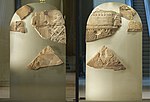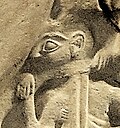The Stele of the Vultures is a monument from the Early Dynastic IIIb period (2600–2350 BC) in Mesopotamia celebrating a victory of the city-state of Lagash...
12 KB (1,422 words) - 21:28, 27 November 2024
Eannatum (category Kings of Lagash)
the ruler of Umma, finally making a boundary treaty with Enakalle, successor of Ush, as described in the Stele of the Vultures and in the Cone of Entemena:...
15 KB (1,374 words) - 03:01, 9 January 2025
ground or in trees. A group of vultures that are feeding is termed a 'wake'. Although New World vultures and Old World vultures share many resemblances,...
25 KB (2,769 words) - 09:17, 18 November 2024
Sumer (redirect from Ancient Sumer (Eight Features of Civilization))
terror as a matter of policy. Eannatum's Stele of the Vultures depicts vultures pecking at the severed heads and other body parts of his enemies. His empire...
109 KB (12,431 words) - 21:21, 22 December 2024
Mesopotamia (redirect from The Two Rivers)
The later Stele of the Vultures at the end of the Early Dynastic III period (2600–2350 BC), commemorating the victory of Eannatum of Lagash over the neighbouring...
90 KB (10,458 words) - 21:29, 7 January 2025
Umma–Lagash war (category Water politics in the Middle East)
it is perhaps the first authentically recorded military campaign in the history of the world. The Stele of the Vultures is one of the first visual representations...
15 KB (1,447 words) - 21:08, 3 May 2024
media related to Steles. Cantabrian stelae Headstone Kurgan stelae Monumental inscription Obelisk Runestone Stećci Stele of the Vultures The plural in English...
36 KB (3,918 words) - 04:47, 9 January 2025
film The Vultures (1975 film), a Quebec film The Vultures (1984 film), a French adventure film "Vultures" (poem), by Chinua Achebe "The Vulture" (short...
5 KB (658 words) - 07:08, 24 December 2024
Shield wall (category Military units and formations of the Middle Ages)
military tactics, the Stele of the Vultures depicts Sumerian soldiers in a shield wall formation during the third millennium BC. By the seventh century...
9 KB (1,170 words) - 18:32, 14 December 2024
Gu-Edin (category Plains of Iraq)
monument called a stele, but Umma continued to feel that Lagash were unfairly advantaged by it. It is recorded on the Stele of the Vultures that Gu-Edin was...
7 KB (704 words) - 16:27, 26 June 2024
battlefield. Stele of the Vultures. Soldiers of Enakalle being left to the vultures, after their defeat by Eannatum of Lagash. Stele of the Vultures. Prisoners...
6 KB (503 words) - 02:43, 9 January 2025
Lagash (redirect from Second dynasty of Lagash)
over the Guʾedena, a fertile area lying between them. As described in Stele of the Vultures, of which only a portion has been found (7 fragments), the current...
66 KB (7,040 words) - 20:12, 29 October 2024
The Mesha Stele, also known as the Moabite Stone, is a stele dated around 840 BCE containing a significant Canaanite inscription in the name of King Mesha...
57 KB (6,329 words) - 15:06, 22 December 2024
Khopesh (category Pages using the WikiHiero extension)
the New Kingdom period. The earliest known depiction of a khopesh is from the Stele of the Vultures, depicting King Eannatum of Lagash wielding the weapon;...
7 KB (530 words) - 18:38, 15 November 2024
would explain them; the fragmentary Stele of the Vultures is an early example of the inscribed type, and the Assyrian Black Obelisk of Shalmaneser III a...
85 KB (8,811 words) - 06:58, 8 December 2024
Ur-Nanshe (category Kings of Lagash)
Lagash by defeating Umma as illustrated in the Stele of the Vultures and continued the building and renovation of Ur-Nanshe's original buildings. He ascended...
22 KB (1,922 words) - 19:45, 8 January 2025
Phalanx (category Infantry units and formations of Macedon)
civilization. The earliest known depiction of a phalanx-like formation occurs in the Sumerian Stele of the Vultures from the 25th century BC. Here the troops...
42 KB (5,877 words) - 02:31, 22 December 2024
Louvre (redirect from McDonald's (The Louvre))
and the city of Akkad, with monuments such as the Prince of Lagash's Stele of the Vultures from 2450 BC and the stele erected by Naram-Sin, King of Akkad...
144 KB (15,162 words) - 13:39, 6 January 2025
Mona Lisa (redirect from The Mona Lisa)
masterpiece of the Italian Renaissance, it has been described as "the best known, the most visited, the most written about, the most sung about, [and] the most...
105 KB (10,496 words) - 19:41, 5 January 2025
Girsu (category Populated places established in the 3rd millennium BC)
André Parrot in 1931–1933. It was at Girsu that the fragments of the Stele of the Vultures were found. The site has suffered from poor excavation standards...
21 KB (1,985 words) - 02:59, 3 December 2024
Sin (mythology) (category Kings of the gods)
Early Dynastic Lagash, he appears among the deities invoked in an oath formula on the Stele of the Vultures, as well as in both Sumerian and Akkadian...
102 KB (14,071 words) - 07:16, 2 January 2025
Near Eastern archaeology (redirect from Archaeology of the Near East)
branch of the wider, global discipline of archaeology. It refers generally to the excavation and study of artifacts and material culture of the Near East...
8 KB (938 words) - 09:57, 6 April 2024
War (redirect from The Causes Of War)
between the armed forces of states, or between governmental forces and armed groups that are organized under a certain command structure and have the capacity...
109 KB (11,148 words) - 08:04, 5 January 2025
Akurgal (category Kings of Lagash)
inscription on the Stele of the Vultures, describing the conflict of Akurgal with Lagash, possibly with Ush, king of Umma: "Because of […] the man of Umma spoke...
7 KB (492 words) - 00:37, 9 January 2025
Babylon. The primary copy of the text is inscribed on a basalt stele 2.25 m (7 ft 4+1⁄2 in) tall. The stele was rediscovered in 1901 at the site of Susa in...
101 KB (9,949 words) - 21:41, 7 January 2025
Early Dynastic Period (Mesopotamia) (redirect from Early Dynastic Period of Sumer)
Winter, I. (1985), "After the Battle is Over: The 'Stele of the Vultures' and the beginning of Historical Narrative in the Ancient Near East", in Kessler...
78 KB (9,254 words) - 09:36, 24 November 2024
Liberty Leading the People (French: La Liberté guidant le peuple [la libɛʁte ɡidɑ̃ lə pœpl]) is a painting of the Romantic era by the French artist Eugène...
27 KB (2,809 words) - 14:56, 2 January 2025
Akkadian Empire (redirect from Arrival of the Semites to Babylonia and Assyria)
high, contributing to the rise of militarism apparent immediately before the Akkadian period (as seen in the Stele of the Vultures of Eannatum). Warfare...
89 KB (10,570 words) - 16:04, 30 November 2024
Encyclopedia of Mythology and Folklore p. 201 Winter, Irene J., "After the Battle Is Over: The ‘Stele of the Vultures’ and the Beginning of Historical Narrative...
114 KB (465 words) - 15:04, 9 January 2025
The Coronation of Napoleon (French: Le Sacre de Napoléon) is a painting completed in 1807 by Jacques-Louis David, the official painter of Napoleon, depicting...
10 KB (1,227 words) - 00:30, 22 December 2024


























